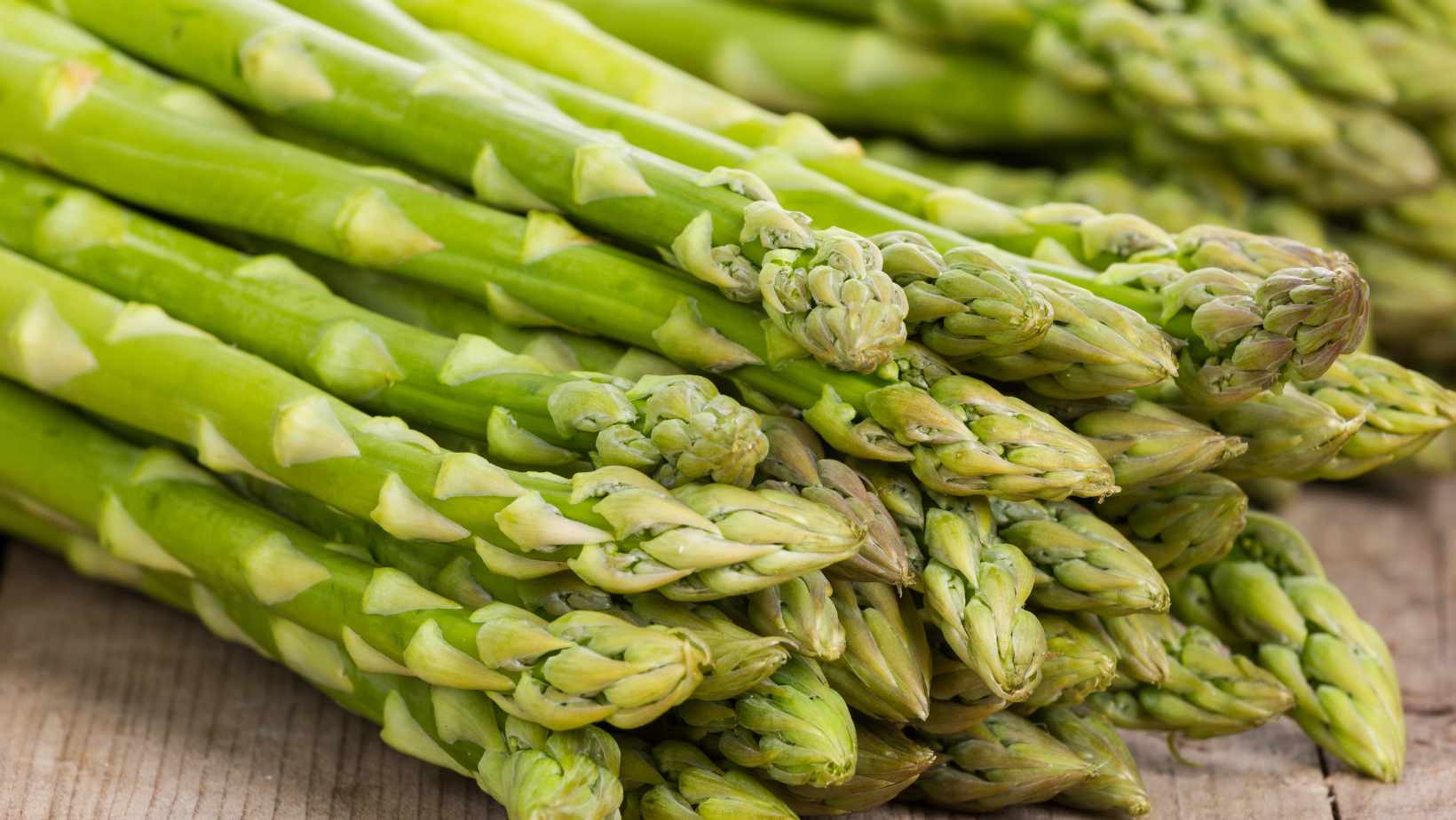
To make sure each person gets the right amount of asparagus when serving, you need to calculate the serving size beforehand. This section ‘How much asparagus per person?’ with sub-sections ‘Calculation for how much asparagus per person’ and ‘Factors affecting how much asparagus per person’ will help you find the ideal serving size and take crucial factors into consideration while serving.
How much asparagus per person
When catering or cooking for a gathering, it’s essential to determine the appropriate amount of asparagus per person. Based on experts’ recommendation, calculate how much asparagus per person by using this simple guideline: 1 pound fresh asparagus yields approximately 4 servings.
Below is a table to calculate the number of pounds required based on the number of individuals:
| Number of People | Pounds of Asparagus |
| 4 | 1 |
| 6 | 1.5 |
| 8 | 2 |
| 10 | 2.5 |
It’s important to note that not all guests may consume asparagus, so consider any dietary restrictions or preferences when calculating how much asparagus to prepare.
It’s also crucial to ensure that the quality of asparagus purchased is up to par with your expectations. Look for firm and straight spears with tight tips and avoid any signs of withering or discoloration.
Don’t let guests miss out on enjoying their fair share of delicious asparagus. Use this calculation guide for your next gathering and be confident that you’re preparing enough for everyone’s tastes and preferences.
Whether your guests are asparagus novices or gluttons for green, these factors will help you determine just how much to serve up.
Factors affecting how much asparagus per person
Factors that influence how much asparagus to serve per individual depend on several variables. These factors can be based on the type of meal, the size of the group, and personal preferences. You need to determine how much asparagus per head dependent on these considerations.
In this table, we present some detailed examples of how much asparagus you should serve depending on the situation. The presentation is based on three primary considerations: the type of meal, the number of servings per person, and a serving size per head. If you’re looking for an accurate estimation of how much asparagus per guest to prepare at your dinner party or special event, these measurements may come in handy.
| Type of Meal | Asparagus Serving Size |
| Breakfast | 1-2 medium spears |
| Lunch | 3-5 medium spears |
| Dinner | 6-8 medium spears |
Apart from these factors mentioned earlier that affect serving sizes, you must factor in the cooking method and presentation mode to determine final requirements for your asparagus preparation.
A healthy way to cook Asparagus is by steaming. Steaming results in minimal loss of nutrients when compared with boiling or other cooking methods.
According to research carried out at Purdue University in West Lafayette, Indiana, eating a good amount of asparagus daily boosts digestive health significantly by developing essential bacteria in your gut that support regular digestion.
Give your asparagus the royal treatment: store them standing up in a jar of water, like they’re the queen’s prized bouquet.
How to store asparagus?
To ensure that you can enjoy fresh asparagus for longer, follow these simple steps for storing asparagus. With the sub-sections of choosing ripe asparagus for storage, proper preparation before storage, storing asparagus in the refrigerator, and storing asparagus in the freezer, you will have a variety of options to keep your asparagus fresh and delicious.
Choosing ripe asparagus for storage
When selecting asparagus for storage, it is important to choose ripe and healthy stems. Here’s what you need to look for:
- Choose firm and straight asparagus stalks with closed buds at the tips.
- Avoid dry or wilted stems.
- The color should be bright green or purple (if it’s a purple variety).
- The thickness of the stem does not necessarily indicate quality, but thicker stemmed asparagus tends to have a heartier flavor.
- Smell the asparagus – it should have a fresh, earthy scent.
To ensure maximum freshness and longevity of stored asparagus, wrap the stems in damp paper towels or store them upright in a jar of water. This will prevent wilting and maintain their crispness. It is also important to note that storing asparagus for too long can reduce its nutritional value, so it’s best to consume within a week of purchase. Don’t miss out on enjoying delicious, nutritious asparagus by choosing poorly stored or overly-aged produce. Follow these tips for optimal storage and enjoy your crisp and flavorful stalks! Preparing asparagus for storage is like a breakup – you want to make sure it ends well and doesn’t turn into a mushy mess.
Proper preparation before storage
Proper handling of asparagus before storing is crucial for retaining its texture and flavor. Here are some points to ensure its freshness:
- Trim off the bottom ends of the asparagus spears using a sharp knife or snap them off by bending them until they break.
- Wash the spears thoroughly under running water and dry them off with a paper towel.
- If you want to store them wrapped, secure the asparagus in a damp paper towel and place it in a plastic bag. Otherwise, keep them upright in a glass jar with water, covering only the ends.
- Avoid exposure to heat and light by keeping it refrigerated, preferably at 32-36°F.
- Extend their shelf-life by consuming them within five days from purchase.
It is important to note that if there is any woody part on your asparagus spears, you should peel it away. The peeling can be done by holding each spear midway and running a vegetable peeler from midway towards the base while applying very little pressure.
Pro Tip: To retain as much of their natural goodness as possible, avoid washing your asparagus until you’re ready to use them.
Keep your asparagus fresh in the fridge, and not in the compost bin, with these easy storage tips!
Storing asparagus in the refrigerator
Asparagus is a delicate vegetable that requires careful storage to maintain its flavor and freshness. To keep your asparagus crisp and tasty, you need to learn the art of storing it in your refrigerator efficiently.
- Trim the ends: Cut off the bottom quarter inch of the spears and make sure they are dry before storing
- Wrap in damp paper towels: Dampen paper towels and carefully wrap them around the asparagus, then place them in a plastic bag or container with a tight-fitting lid.
- Store upright in the refrigerator: Make sure that the tips are pointing up and that the spears are not too tightly packed together.
It’s essential to remember that asparagus has a short shelf life, so it’s best to consume it within three days of purchasing or picking. Additionally, avoid washing asparagus before storing it; otherwise, it will spoil faster.
Pro Tip: To extend its shelf life by one or two extra days, stand asparagus upright in a jar or container with about an inch of water at the bottom before wrapping it in damp paper towels.
Freezing asparagus is like putting it on ice – it may not be as fresh, but it’ll still come in handy when you’re in a pickle.
Storing asparagus in the freezer
When it comes storing asparagus in the freezer, it’s essential to follow a few specific steps to ensure that the asparagus stays fresh and retains its flavor. Here’s a simple guide that can help:
- Start by washing the asparagus thoroughly in cold water and patting them dry with a paper towel.
- Cut off any tough or woody parts of the asparagus.
- Blanch the asparagus by boiling them for 1-2 minutes, then transferring them to ice-cold water for roughly 3-4 minutes.
- Drain off any water mixture from the blanched asparagus and arrange the spears in a single layer on a baking tray lined with parchment paper.
- Place the tray of arranged spears inside your freezer and leave them there until they are fully frozen (2-4 hours).
- Afterward, transfer the frozen spears into an air-tight container or freezer bag.
Remember, once you’ve thawed out your frozen asparagus, they may not retain their crispness but can still be used for cooking purposes such as soups or casseroles.
While storing your asparagus in the freezer is an excellent way to preserve them, It’s crucial to keep in mind that they should stay frozen at all times until ready for use.
As a fun fact, did you know that ancient Greeks often consumed dried asparagus roots believing them to have medicinal properties?
Let’s be real, if you’re storing asparagus for more than a few days, you’re just delaying the inevitable mushiness.
How long can asparagus be stored?
To ensure you always have fresh asparagus on hand, it’s important to know how long it can be stored. In order to help you maintain the quality of your asparagus, this section with the title ‘How long can asparagus be stored?’ with sub-sections ‘Shelf life of asparagus in the refrigerator, Shelf life of asparagus in the freezer, and Signs of spoiled asparagus’ provides you with all the necessary information to keep your asparagus fresh for as long as possible.
Shelf life of asparagus in the refrigerator
Asparagus is a perishable vegetable with a limited shelf life. Like any other fresh produce, it’s important to know how long it can be stored in the refrigerator to avoid any potential health hazards and maintain its quality.
- Asparagus can last for up to one week in the refrigerator.
- The best way to store asparagus is by wrapping it in a damp paper towel and placing it inside an airtight container or plastic bag.
- It’s important to keep asparagus away from moisture and condensation as they can promote bacterial growth, leading to spoilage.
- If you have leftover cooked asparagus, it should be placed in an airtight container and consumed within 3-4 days.
Interestingly, the age of the asparagus also plays an important role in its shelf life. The younger asparagus tends to have a longer shelf life compared to older ones.
To ensure that your asparagus stays fresh for longer, you should only buy what you need, and consume them within the recommended time frame.
Don’t miss out on enjoying the delicious taste of fresh asparagus just because you didn’t consume it on time. Always store your asparagus properly and make sure you use them before they start showing signs of spoilage.
Freeze asparagus forever and always be prepared for guacamole emergencies.
Shelf life of asparagus in the freezer
The duration asparagus can be stored in the freezer is dependent on several factors. It is recommended to store fresh asparagus in the freezer for optimum shelf life.
| Factors | Shelf Life (in months) |
| Frozen Asparagus | 8-10 months |
| Vacuum-packed Asparagus | 12-14 months |
| Blanched and Frozen Asparagus | 12 months |
It’s important to remember that freezing dehydrates asparagus, which means it will become softer and lose its crunchiness. If properly stored, frozen asparagus can retain most of its flavor and nutritional value. When storing fresh asparagus in the freezer, ensure that it is thoroughly washed before blanching it in boiling water for a minute or two. Immediately plunge into ice-cold water for two minutes and then drain off excess water. Finally, transfer to a tightly sealed container or bag before placing in the freezer. To enhance shelf life, vacuum-packing prevents moisture from interfering with the asparagus quality and prolongs its storage period. Blanched and frozen asparagus will last longer than raw ones because blanching kills bacteria that cause spoilage. Always use proper storage techniques and ensure that your freezer is set at optimal temperatures. Freezing asparagus can provide significant cost savings since it allows you to enjoy this vegetable all year round. Eating spoiled asparagus is like playing a game of vegetable roulette – except the stakes are much higher.
Signs of spoiled asparagus
Asparagus that has gone bad should not be consumed. Identifying spoiled asparagus is crucial to avoid consuming anything harmful. Here’s how to identify Spoiled Asparagus:
- Discoloration: Presence of dark spots on the stem indicates spoilage.
- Odor: The smell will be unpleasant and strong if the asparagus has gone bad.
- Texture: Slimy or mushy feel in the tips making them unusable.
- Dullness: Dull, brownish, or yellowish tint shows it’s no longer fresh.
- Bends easily: Asparagus that bends easily could be bad and shouldn’t be eaten.
- Sour taste when cooked or eaten raw indicates it has been spoiled.
In addition to these signs of spoiled asparagus, it’s essential to note that fresh asparagus can last up to a week if stored properly in the refrigerator. Make sure you keep your asparagus wrapped in a damp cloth or paper towel stored in an airtight container without washing them first.
It’s true that storing asparagus can be tricky but with some cautious steps, it can last up to a week. According to Mayo Clinic, keeping the vegetable between 32°F (0°C) and 40°F (4°C) is ideal for long-term storage.
Keep your asparagus as fresh as your jokes with these tips!
Tips for maximizing the freshness of asparagus
To maximize the freshness of your asparagus and ensure a delicious and healthy meal, follow these tips for storing asparagus. Keep your asparagus hydrated and avoid exposing it to sunlight. Store your asparagus at the proper temperature and wrap it properly for storage. These simple steps can help you enjoy fresh, crispy asparagus every time you cook.
Keeping asparagus hydrated
To preserve the freshness of asparagus and enhance its shelf life, maintaining optimal hydration levels is crucial. Ensure that the asparagus is stored in cool temperatures with a damp cloth covering its ends to prevent water loss. This will also allow for better nutrient retention and crunchier texture. Furthermore, hydrating the asparagus should be done at home as well. Trim the stems by an inch or so before placing them upright in a container of water. Change the water frequently to prevent bacterial growth and maintain freshness. It is important to note that overhydration can cause asparagus to become mushy and lose its flavor, so moderation is key. Avoid soaking it for extended periods or leaving it in standing water for too long. In a study conducted by the University of Georgia, storing asparagus in 2-3°C with 90-95% relative humidity enhanced its freshness significantly. If asparagus could talk, they’d tell you to keep them out of the sun like a vampire at a beach party.
Avoiding exposure to sunlight
To preserve the freshness of asparagus, it is crucial to prevent it from being exposed to direct sunlight. Sunlight can accelerate the process of decay and cause the vegetable to become slimy and lose its bright green color.
One way to avoid exposing asparagus to sunlight is by storing it in a cool, dark place like the refrigerator. You can wrap the asparagus in a damp paper towel or plastic bag to keep it moist and prevent moisture loss.
Another way to protect asparagus from sunlight exposure is by buying it when it is still fresh and keeping it away from windows or other areas with high light exposure.
By following these practices, you can ensure that your asparagus stays fresh for longer periods and retains its optimal flavor and texture.
A study conducted by Michigan State University found that storing asparagus at a temperature between 32°F and 36°F helps maintain its freshness.
Keep your asparagus cool and fresh, unlike your ex’s attempts at reconciliation.
Storing asparagus at the optimal temperature
Storing asparagus at the ideal temperature is crucial to maximize its freshness and shelf life. Keeping the temperature optimal can help preserve asparagus’s rich nutrients and flavors for an extended period.
To store asparagus correctly, wrap it with a damp paper towel or cloth and place it in a plastic bag. Ensure that the packaging is tightly sealed to prevent moisture loss. Store it in the refrigerator’s crisper drawer at a temperature between 32°F to 36°F (0°C-2.2°C).
| Temperature | Shelf Life |
| 32°F – 36°F | 1-2 weeks |
To maintain the freshness of asparagus longer, one can also try freezing it after blanching, but it might result in texture changes.
Asparagus is nutritionally rich with vitamins A, C, E, K, folate, and antioxidants. According to a study published in The Journal of Agricultural Food Chemistry, microwaving asparagus-based dishes does not only retain its nutrients but also increases health-promoting antioxidants.
True Fact:
“The United States produces over half of the world’s supply of asparagus – around 100 million pounds of Asparagus annually.” (Source: USDA Global Agricultural Information Network).
Wrapping asparagus properly is like swaddling a fragile newborn, except this baby’s lifespan is much shorter.
Properly wrapping asparagus for storage
One of the keys to maintaining asparagus’ freshness is by properly storing it. Ensuring that asparagus stays crisp and tasty requires attention to detail, including carefully wrapping it for storage.
Here’s a 4-Step Guide to Properly Wrap Asparagus for Storage:
- Start by trimming the woody ends of each asparagus spear.
- Next, wrap a damp paper towel around the trimmed bunch of asparagus.
- Place the bundle into a ziplock bag. Make sure to expel excess air from the bag before sealing it tightly.
- Store your wrapped asparagus in your fridge drawer’s warmer section where temperatures are between 32 and 36 degrees Fahrenheit.
For maximum freshness benefits, be careful not to overwrap your asparagus. Doing so might cause unpleasant odors or flavors when reheated.
To save money and avoid wasting food, rinse your fresh asparagus in cold water before storing them. Wrapping this versatile vegetable can help retain its flavor and texture for more extended periods.
Ensure you get the most out of your fresh veggies with proper wrapping techniques. Don’t let poor storage affect your produce’s quality or limit its shelf-life.
Keep Your Fresh Asparagus Crisp and Delicious!
Keep your asparagus fresher for longer, so you have more time to contemplate the crushing inevitability of decay and deterioration in all things.
